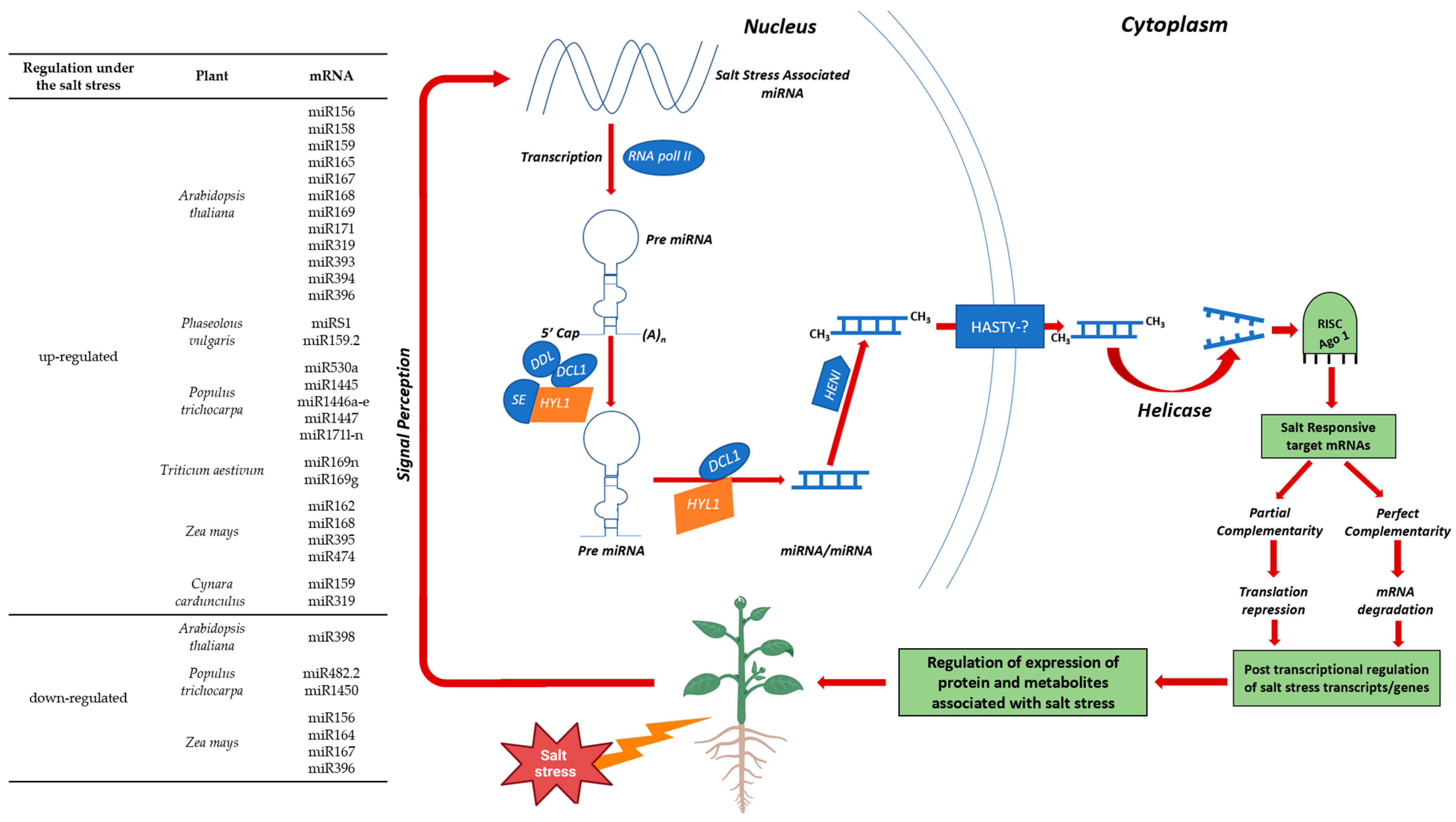Strategies for Achieving High and Sustainable Plant Productivity in Saline Soil Conditions
Abstract
1. Introduction
2. Sustainable Plant Strategies in Mitigating Salinity Stress Conditions
2.1. Modification of Plant Primary Metabolite Response to Salinity Stress
2.2. Plant Secondary Metabolite Modification in Response to Salinity Stress
3. Manipulation of Plant Antioxidant Pathways Under Saline Conditions
4. Advances in Plant Genetic Engineering to Withstand Salinity Stress
RNA Interference Technology for Enhancing Plants’ Saline Soil Stress Tolerance
5. Engineered Nanoparticles and Nanomaterials to Improve the Resilience of Plants Exposed to Salinity Stress
6. Arbuscular Mycorrhizal Fungi (AMF) and Plant Growth-Promoting Bacteria (PGPB) Mediate the Growth of Plants Exposed to Salinity Stress
7. Organic Amendments Moderate Plant Growth and Biomass Allocation under Salinity Stress
8. Trace Elements Used in Salinity Stress Alleviation
9. Concluding Remarks and Future Perspectives
Author Contributions
Funding
Data Availability Statement
Conflicts of Interest
References
- Goswami, D.; Thakker, J.N.; Dhandhukia, P.C. Portraying Mechanics of Plant Growth Promoting Rhizobacteria (PGPR): A Review. Cogent Food Agric. 2016, 2, 1127500. [Google Scholar] [CrossRef]
- Saghafi, D.; Delangiz, N.; Lajayer, B.A.; Ghorbanpour, M. An Overview on Improvement of Crop Productivity in Saline Soils by Halotolerant and Halophilic PGPRs. 3 Biotech 2019, 9, 261. [Google Scholar] [CrossRef] [PubMed]
- Vaishnav, A.; Varma, A.; Tuteja, N.; Choudhary, D.K. PGPR-Mediated Amelioration of Crops Under Salt Stress. In Plant-Microbe Interaction: An Approach to Sustainable Agriculture; Choudhary, D.K., Varma, A., Tuteja, N., Eds.; Springer: Singapore, 2016; pp. 205–226. ISBN 978-981-10-2854-0. [Google Scholar]
- Yergaliyev, T.M.; Nurbekova, Z.; Mukiyanova, G.; Akbassova, A.; Sutula, M.; Zhangazin, S.; Bari, A.; Tleukulova, Z.; Shamekova, M.; Masalimov, Z.K.; et al. The Involvement of ROS Producing Aldehyde Oxidase in Plant Response to Tombusvirus Infection. Plant Physiol. Biochem. 2016, 109, 36–44. [Google Scholar] [CrossRef]
- Sutula, M.Y.; Akbassova, A.Z.; Yergaliyev, T.M.; Nurbekova, Z.A.; Mukiyanova, G.S.; Omarov, R.T. Endowing Plants with Tolerance to Virus Infection by Their Preliminary Treatment with Short Interfering RNAs. Russ. J. Plant Physiol. 2017, 64, 939–945. [Google Scholar] [CrossRef]
- Srivastava, S.; Brychkova, G.; Yarmolinsky, D.; Soltabayeva, A.; Samani, T.; Sagi, M. Aldehyde Oxidase 4 Plays a Critical Role in Delaying Silique Senescence by Catalyzing Aldehyde Detoxification. Plant Physiol. 2017, 173, 1977–1997. [Google Scholar] [CrossRef]
- Nurbekova, Z.; Srivastava, S.; Standing, D.; Kurmanbayeva, A.; Bekturova, A.; Soltabayeva, A.; Oshanova, D.; Turečková, V.; Strand, M.; Biswas, M.S.; et al. Arabidopsis Aldehyde Oxidase 3, Known to Oxidize Abscisic Aldehyde to Abscisic Acid, Protects Leaves from Aldehyde Toxicity. Plant J. 2021, 108, 1439–1455. [Google Scholar] [CrossRef]
- Kurmanbayeva, A.; Bekturova, A.; Soltabayeva, A.; Oshanova, D.; Nurbekova, Z.; Srivastava, S.; Tiwari, P.; Dubey, A.K.; Sagi, M. Active O-Acetylserine-(Thiol) Lyase A and B Confer Improved Selenium Resistance and Degrade l-Cys and l-SeCys in Arabidopsis. J. Exp. Bot. 2022, 73, 2525–2539. [Google Scholar] [CrossRef] [PubMed]
- Soltabayeva, A.; Bekturova, A.; Kurmanbayeva, A.; Oshanova, D.; Nurbekova, Z.; Srivastava, S.; Standing, D.; Sagi, M. Ureides Are Accumulated Similarly in Response to UV-C Irradiation and Wounding in Arabidopsis Leaves but Are Remobilized Differently during Recovery. J. Exp. Bot. 2022, 73, 1016–1032. [Google Scholar] [CrossRef]
- Horie, T.; Karahara, I.; Katsuhara, M. Salinity Tolerance Mechanisms in Glycophytes: An Overview with the Central Focus on Rice Plants. Rice 2012, 5, 11. [Google Scholar] [CrossRef]
- Munns, R.; Tester, M. Mechanisms of Salinity Tolerance. Annu. Rev. Plant Biol. 2008, 59, 651–681. [Google Scholar] [CrossRef] [PubMed]
- Aubakirova, K.; Satkanov, M.; Kulataeva, M.; Assylbekova, G.; Kambarbekova, A.; Alikulov, Z. Molybdoenzymes Isolated from S. glanis Liver Can Produce Nitric Oxide from Nitrates and Nitrites. Czech J. Anim. Sci. 2023, 68, 222–230. [Google Scholar] [CrossRef]
- Aitlessov, K.; Zhumabekova, B.; Sagyndykov, U.; Tuyakbayeva, A.; Bitkeyeva, A.; Bazarbaeva, K.Z.; Mukhtarov, A.; Nurbekova, Z.; Satkanov, M.; Kulatayeva, M.; et al. Foliar Fertilization with Molybdate and Nitrate Up-Regulated Activity of Nitrate Reductase in Lemon Balm Leaves. Horticulturae 2023, 9, 1325. [Google Scholar] [CrossRef]
- Kumar, A.; Singh, S.; Gaurav, A.K.; Srivastava, S.; Verma, J.P. Plant Growth-Promoting Bacteria: Biological Tools for the Mitigation of Salinity Stress in Plants. Front. Microbiol. 2020, 11, 1216. [Google Scholar] [CrossRef] [PubMed]
- Sultana, M.S.; Sakurai, C.; Biswas, M.S.; Szabados, L.; Mano, J. Accumulation of Reactive Carbonyl Species in Roots as the Primary Cause of Salt Stress-Induced Growth Retardation of Arabidopsis thaliana. Physiol. Plant. 2024, 176, e14198. [Google Scholar] [CrossRef]
- Yan, K.; Shao, H.; Shao, C.; Chen, P.; Zhao, S.; Brestic, M.; Chen, X. Physiological Adaptive Mechanisms of Plants Grown in Saline Soil and Implications for Sustainable Saline Agriculture in Coastal Zone. Acta Physiol. Plant. 2013, 35, 2867–2878. [Google Scholar] [CrossRef]
- Gupta, B.; Huang, B. Mechanism of Salinity Tolerance in Plants: Physiological, Biochemical, and Molecular Characterization. Int. J. Genom. 2014, 2014, 701596. [Google Scholar] [CrossRef]
- Sisay, T.A.; Nurbekova, Z.; Oshanova, D.; Dubey, A.K.; Khatri, K.; Mudgal, V.; Mudgal, A.; Neori, A.; Shpigel, M.; Srivastava, R.K.; et al. Effect of Salinity and Nitrogen Fertilization Levels on Growth Parameters of Sarcocornia fruticosa, Salicornia brachiata, and Arthrocnemum macrostachyum. Agronomy 2022, 12, 1749. [Google Scholar] [CrossRef]
- Saberi Riseh, R.; Ebrahimi-Zarandi, M.; Tamanadar, E.; Moradi Pour, M.; Thakur, V.K. Salinity Stress: Toward Sustainable Plant Strategies and Using Plant Growth-Promoting Rhizobacteria Encapsulation for Reducing It. Sustainability 2021, 13, 12758. [Google Scholar] [CrossRef]
- Mishra, A.K.; Das, R.; George Kerry, R.; Biswal, B.; Sinha, T.; Sharma, S.; Arora, P.; Kumar, M. Promising Management Strategies to Improve Crop Sustainability and to Amend Soil Salinity. Front. Environ. Sci. 2023, 10, 962581. [Google Scholar] [CrossRef]
- Blumwald, E.; Aharon, G.S.; Apse, M.P. Sodium Transport in Plant Cells. Biochim. Biophys. Acta (BBA)-Biomembr. 2000, 1465, 140–151. [Google Scholar] [CrossRef]
- Junedi, M.A.; Mukhopadhyay, R.; Manjari, K.S. Alleviating Salinity Stress in Crop Plants Using New Engineered Nanoparticles (ENPs). Plant Stress 2023, 9, 100184. [Google Scholar] [CrossRef]
- Oh, D.-H.; Lee, S.Y.; Bressan, R.A.; Yun, D.-J.; Bohnert, H.J. Intracellular Consequences of SOS1 Deficiency during Salt Stress. J. Exp. Bot. 2010, 61, 1205–1213. [Google Scholar] [CrossRef]
- Zhao, X.; Wei, P.; Liu, Z.; Yu, B.; Shi, H. Soybean Na+/H+ Antiporter GmsSOS1 Enhances Antioxidant Enzyme Activity and Reduces Na+ Accumulation in Arabidopsis and Yeast Cells under Salt Stress. Acta Physiol. Plant. 2016, 39, 19. [Google Scholar] [CrossRef]
- Feki, K.; Quintero, F.J.; Khoudi, H.; Leidi, E.O.; Masmoudi, K.; Pardo, J.M.; Brini, F. A Constitutively Active Form of a Durum Wheat Na+/H+ Antiporter SOS1 Confers High Salt Tolerance to Transgenic Arabidopsis. Plant Cell Rep. 2014, 33, 277–288. [Google Scholar] [CrossRef]
- Gao, J.; Sun, J.; Cao, P.; Ren, L.; Liu, C.; Chen, S.; Chen, F.; Jiang, J. Variation in Tissue Na+ Content and the Activity of SOS1 Genes among Two Species and Two Related Genera of Chrysanthemum. BMC Plant Biol. 2016, 16, 98. [Google Scholar] [CrossRef]
- Amin, I.; Rasool, S.; Mir, M.A.; Wani, W.; Masoodi, K.Z.; Ahmad, P. Ion Homeostasis for Salinity Tolerance in Plants: A Molecular Approach. Physiol. Plant. 2021, 171, 578–594. [Google Scholar] [CrossRef] [PubMed]
- Liu, X.; Cai, S.; Wang, G.; Wang, F.; Dong, F.; Mak, M.; Holford, P.; Ji, J.; Salih, A.; Zhou, M.; et al. Halophytic NHXs Confer Salt Tolerance by Altering Cytosolic and Vacuolar K+ and Na+ in Arabidopsis Root Cell. Plant Growth Regul. 2017, 82, 333–351. [Google Scholar] [CrossRef]
- Ye, C.-Y.; Zhang, H.-C.; Chen, J.-H.; Xia, X.-L.; Yin, W.-L. Molecular Characterization of Putative Vacuolar NHX-Type Na+/H+ Exchanger Genes from the Salt-Resistant Tree Populus euphratica. Physiol. Plant 2009, 137, 166–174. [Google Scholar] [CrossRef]
- Albaladejo, I.; Meco, V.; Plasencia, F.; Flores, F.B.; Bolarin, M.C.; Egea, I. Unravelling the Strategies Used by the Wild Tomato Species Solanum Pennellii to Confront Salt Stress: From Leaf Anatomical Adaptations to Molecular Responses. Environ. Exp. Bot. 2017, 135, 1–12. [Google Scholar] [CrossRef]
- Gu, S.; Han, S.; Abid, M.; Bai, D.; Lin, M.; Sun, L.; Qi, X.; Zhong, Y.; Fang, J. A High-K+ Affinity Transporter (HKT) from Actinidia valvata Is Involved in Salt Tolerance in Kiwifruit. Int. J. Mol. Sci. 2023, 24, 15737. [Google Scholar] [CrossRef]
- Irulappan, V.; Park, H.W.; Han, S.-Y.; Kim, M.-H.; Kim, J.S. Genome-Wide Identification of a Novel Na+ Transporter from Bienertia sinuspersici and Overexpression of BsHKT1;2 Improved Salt Tolerance in Brassica rapa. Front. Plant Sci. 2023, 14, 1302315. [Google Scholar] [CrossRef] [PubMed]
- Zhang, H.; Qi, C.; Li, C.; Huang, D.; Mao, H.; Lin, X. Overexpression of High Affinity K+ Transporter from Nitraria sibirica Enhanced Salt Tolerance of Transgenic Plants. Plant Sci. 2024, 342, 112052. [Google Scholar] [CrossRef] [PubMed]
- Yuan, D.; Wu, X.; Jiang, X.; Gong, B.; Gao, H. Types of Membrane Transporters and the Mechanisms of Interaction between Them and Reactive Oxygen Species in Plants. Antioxidants 2024, 13, 221. [Google Scholar] [CrossRef] [PubMed]
- Do, T.D.; Chen, H.; Hien, V.T.T.; Hamwieh, A.; Yamada, T.; Sato, T.; Yan, Y.; Cong, H.; Shono, M.; Suenaga, K.; et al. Ncl Synchronously Regulates Na+, K+ and Cl− in Soybean and Greatly Increases the Grain Yield in Saline Field Conditions. Sci. Rep. 2016, 6, 19147. [Google Scholar] [CrossRef] [PubMed]
- Wang, P.; Li, Z.; Wei, J.; Zhao, Z.; Sun, D.; Cui, S. A Na+/Ca2+ Exchanger-like Protein (AtNCL) Involved in Salt Stress in Arabidopsis. J. Biol. Chem. 2012, 287, 44062–44070. [Google Scholar] [CrossRef] [PubMed]
- Li, P.; Zhang, G.; Gonzales, N.; Guo, Y.; Hu, H.; Park, S.; Zhao, J. Ca2+-Regulated and Diurnal Rhythm-Regulated Na+/Ca2+ Exchanger AtNCL Affects Flowering Time and Auxin Signalling in Arabidopsis. Plant Cell Environ. 2016, 39, 377–392. [Google Scholar] [CrossRef] [PubMed]
- Shumayla; Tyagi, S.; Sharma, Y.; Madhu; Sharma, A.; Pandey, A.; Singh, K.; Upadhyay, S.K. Expression of TaNCL2-A Ameliorates Cadmium Toxicity by Increasing Calcium and Enzymatic Antioxidants Activities in Arabidopsis. Chemosphere 2023, 329, 138636. [Google Scholar] [CrossRef] [PubMed]
- Apel, K.; Hirt, H. Reactive Oxygen Species: Metabolism, Oxidative Stress, and Signal Transduction. Annu. Rev. Plant Biol. 2004, 55, 373–399. [Google Scholar] [CrossRef] [PubMed]
- Kumar, R.; Bohra, A.; Pandey, A.K.; Pandey, M.K.; Kumar, A. Metabolomics for Plant Improvement: Status and Prospects. Front. Plant Sci. 2017, 8, 1302. [Google Scholar] [CrossRef]
- Shulaev, V.; Cortes, D.; Miller, G.; Mittler, R. Metabolomics for Plant Stress Response. Physiol. Plant. 2008, 132, 199–208. [Google Scholar] [CrossRef] [PubMed]
- Yancey, P.H. Organic Osmolytes as Compatible, Metabolic and Counteracting Cytoprotectants in High Osmolarity and Other Stresses. J. Exp. Biol. 2005, 208, 2819–2830. [Google Scholar] [CrossRef]
- Kulkarni, J.; Sharma, S.; Sahoo, S.A.; Mishra, S.; Nikam, T.D.; Borde, M.; Penna, S.; Srivastava, A.K. Resilience in Primary Metabolism Contributes to Salt Stress Adaptation in Sesuvium portulacastrum (L.). Plant Growth Regul. 2022, 98, 385–398. [Google Scholar] [CrossRef]
- Widodo; Patterson, J.H.; Newbigin, E.; Tester, M.; Bacic, A.; Roessner, U. Metabolic Responses to Salt Stress of Barley (Hordeum vulgare L.) Cultivars, Sahara and Clipper, Which Differ in Salinity Tolerance. J. Exp. Bot. 2009, 60, 4089–4103. [Google Scholar] [CrossRef]
- Hare, P.D.; Cress, W.A.; Van Staden, J. Dissecting the Roles of Osmolyte Accumulation during Stress. Plant Cell Environ. 1998, 21, 535–553. [Google Scholar] [CrossRef]
- Bohnert, H.J.; Nelson, D.E.; Jensen, R.G. Adaptations to Environmental Stresses. Plant Cell 1995, 7, 1099–1111. [Google Scholar] [CrossRef]
- Kadyrbaev, M.K.; Golovatskaya, I.F.; Satkanov, M.Z. Features of Regenerants Morphogenesis and Metabolism in Vitro, Obtained from Different Fragments of Potato Shoots. Vestn. Tomsk. Gos. Univ. Biol. 2021, 55, 114–134. [Google Scholar] [CrossRef]
- Gong, Q.; Li, P.; Ma, S.; Indu Rupassara, S.; Bohnert, H.J. Salinity Stress Adaptation Competence in the Extremophile Thellungiella halophila in Comparison with Its Relative Arabidopsis thaliana. Plant J. 2005, 44, 826–839. [Google Scholar] [CrossRef] [PubMed]
- Akula, R.; Ravishankar, G.A. Influence of Abiotic Stress Signals on Secondary Metabolites in Plants. Plant Signal. Behav. 2011, 6, 1720–1731. [Google Scholar] [CrossRef]
- Verma, N.; Shukla, S. Impact of Various Factors Responsible for Fluctuation in Plant Secondary Metabolites. J. Appl. Res. Med. Aromat. Plants 2015, 2, 105–113. [Google Scholar] [CrossRef]
- Kusano, M.; Yang, Z.; Okazaki, Y.; Nakabayashi, R.; Fukushima, A.; Saito, K. Using Metabolomic Approaches to Explore Chemical Diversity in Rice. Mol. Plant 2015, 8, 58–67. [Google Scholar] [CrossRef]
- Zagorchev, L.; Seal, C.E.; Kranner, I.; Odjakova, M. A Central Role for Thiols in Plant Tolerance to Abiotic Stress. Int. J. Mol. Sci. 2013, 14, 7405–7432. [Google Scholar] [CrossRef] [PubMed]
- Xin, F.; Yang, C.; Wei, Y.; Ma, Q.X.; Yang, L.; Chen, X.-Y. Genomics Grand for Diversified Plant Secondary Metabolites. Plant Divers. Res. 2011, 33, 53–64. [Google Scholar]
- Wink, M. Modes of Action of Herbal Medicines and Plant Secondary Metabolites. Medicines 2015, 2, 251–286. [Google Scholar] [CrossRef]
- Parida, A.K.; Das, A.B. Salt Tolerance and Salinity Effects on Plants: A Review. Ecotoxicol. Environ. Saf. 2005, 60, 324–349. [Google Scholar] [CrossRef]
- Muthukumarasamy, M.; Gupta, S.D.; Panneerselvam, R. Enhancement of Peroxidase, Polyphenol Oxidase and Superoxide Dismutase Activities by Triadimefon in NaCl Stressed Raphanus sativus L. Biol. Plant. 2000, 43, 317–320. [Google Scholar] [CrossRef]
- Navarro, J.M.; Flores, P.; Garrido, C.; Martinez, V. Changes in the Contents of Antioxidant Compounds in Pepper Fruits at Different Ripening Stages, as Affected by Salinity. Food Chem. 2006, 96, 66–73. [Google Scholar] [CrossRef]
- Pulvento, C.; Riccardi, M.; Lavini, A.; Iafelice, G.; Marconi, E.; d’Andria, R. Yield and Quality Characteristics of Quinoa Grown in Open Field Under Different Saline and Non-Saline Irrigation Regimes. J. Agron. Crop Sci. 2012, 198, 254–263. [Google Scholar] [CrossRef]
- Moses, T.; Papadopoulou, K.K.; Osbourn, A. Metabolic and Functional Diversity of Saponins, Biosynthetic Intermediates and Semi-Synthetic Derivatives. Crit. Rev. Biochem. Mol. Biol. 2014, 49, 439–462. [Google Scholar] [CrossRef]
- Edreva, A.; Velikova, V.; Tsonev, T.; Dagnon, S.; Aktaş, L.; Gesheva, E. Stress-Protective Role of Secondary Metabolites: Diversity of Functions and Mechanisms. Gen. Appl. Plant. Physiol. 2008, 34, 67–78. [Google Scholar]
- Sarri, E.; Termentzi, A.; Abraham, E.M.; Papadopoulos, G.K.; Baira, E.; Machera, K.; Loukas, V.; Komaitis, F.; Tani, E. Salinity Stress Alters the Secondary Metabolic Profile of M. Sativa, M. Arborea and Their Hybrid (Alborea). Int. J. Mol. Sci. 2021, 22, 4882. [Google Scholar] [CrossRef]
- Mukhamejanova, A.; Alikulov, Z.; Shapekova, N.; Aubakirova, K.; Mukhtarov, A. The Effect of Antioxidants on Xanthine Oxidase Activity in Fresh Ovine Milk. Potravin. Slovak J. Food Sci. 2021, 15, 599–607. [Google Scholar] [CrossRef] [PubMed]
- Hernández, J.A.; Jiménez, A.; Mullineaux, P.; Sevilia, F. Tolerance of Pea (Pisum sativum L.) to Long-Term Salt Stress Is Associated with Induction of Antioxidant Defences. Plant Cell Environ. 2000, 23, 853–862. [Google Scholar] [CrossRef]
- Demiral, T.; Türkan, İ. Comparative Lipid Peroxidation, Antioxidant Defense Systems and Proline Content in Roots of Two Rice Cultivars Differing in Salt Tolerance. Environ. Exp. Bot. 2005, 53, 247–257. [Google Scholar] [CrossRef]
- Sarker, U.; Oba, S. The Response of Salinity Stress-Induced A. tricolor to Growth, Anatomy, Physiology, Non-Enzymatic and Enzymatic Antioxidants. Front. Plant Sci. 2020, 11, 559876. [Google Scholar] [CrossRef]
- Hussain, N.; Sohail, Y.; Shakeel, N.; Javed, M.; Bano, H.; Gul, H.S.; Zafar, Z.U.; Frahat Zaky Hassan, I.; Ghaffar, A.; Athar, H.-R.; et al. Role of Mineral Nutrients, Antioxidants, Osmotic Adjustment and PSII Stability in Salt Tolerance of Contrasting Wheat Genotypes. Sci. Rep. 2022, 12, 12677. [Google Scholar] [CrossRef]
- Ali Solangi, K.; Wu, Y.; Xing, D.; Ahmed Qureshi, W.; Hussain Tunio, M.; Ali Sheikh, S.; Shabbir, A. Can Electrophysiological Information Reflect the Response of Mangrove Species to Salt Stress? A Case Study of Rewatering and Sodium Nitroprusside Application. Plant Signal. Behav. 2022, 17, 2073420. [Google Scholar] [CrossRef]
- Jin, T.; Sun, Y.; Zhao, R.; Shan, Z.; Gai, J.; Li, Y. Overexpression of Peroxidase Gene GsPRX9 Confers Salt Tolerance in Soybean. Int. J. Mol. Sci. 2019, 20, 3745. [Google Scholar] [CrossRef]
- Derakhshani, Z.; Bhave, M.; Shah, R.M. Metabolic Contribution to Salinity Stress Response in Grains of Two Barley Cultivars with Contrasting Salt Tolerance. Environ. Exp. Bot. 2020, 179, 104229. [Google Scholar] [CrossRef]
- Balasubramaniam, T.; Shen, G.; Esmaeili, N.; Zhang, H. Plants’ Response Mechanisms to Salinity Stress. Plants 2023, 12, 2253. [Google Scholar] [CrossRef]
- Saradadevi, R.; Mukankusi, C.; Li, L.; Amongi, W.; Mbiu, J.P.; Raatz, B.; Ariza, D.; Beebe, S.; Varshney, R.K.; Huttner, E.; et al. Multivariate Genomic Analysis and Optimal Contributions Selection Predicts High Genetic Gains in Cooking Time, Iron, Zinc, and Grain Yield in Common Beans in East Africa. Plant Genome 2021, 14, e20156. [Google Scholar] [CrossRef]
- Zheng, L.; Chen, S.; Xie, L.; Lu, Z.; Liu, M.; Han, X.; Qiao, G.; Jiang, J.; Zhuo, R.; Qiu, W.; et al. Overexpression of Cysteine Protease Gene from Salix Matsudana Enhances Salt Tolerance in Transgenic arabidopsis. Environ. Exp. Bot. 2018, 147, 53–62. [Google Scholar] [CrossRef]
- Iksat, N.; Masalimov, Z.; Omarov, R. Plant Virus Resistance Biotechnological Approaches: From Genes to the CRISPR/Cas Gene Editing System. J. Water Land Dev. 2023, 57, 147–158. [Google Scholar] [CrossRef]
- Mann, A.; Kumar, N.; Lata, C.; Kumar, A.; Kumar, A.; Meena, B.L. Functional Annotation of Differentially Expressed Genes under Salt Stress in Dichanthium annulatum. Plant Physiol. Rep. 2019, 24, 104–111. [Google Scholar] [CrossRef]
- Joshi, R.; Wani, S.H.; Singh, B.; Bohra, A.; Dar, Z.A.; Lone, A.A.; Pareek, A.; Singla-Pareek, S.L. Transcription Factors and Plants Response to Drought Stress: Current Understanding and Future Directions. Front. Plant Sci. 2016, 7, 1029. [Google Scholar] [CrossRef]
- Sun, X.; Xu, L.; Wang, Y.; Luo, X.; Zhu, X.; Kinuthia, K.B.; Nie, S.; Feng, H.; Li, C.; Liu, L. Transcriptome-Based Gene Expression Profiling Identifies Differentially Expressed Genes Critical for Salt Stress Response in Radish (Raphanus sativus L.). Plant Cell Rep. 2016, 35, 329–346. [Google Scholar] [CrossRef] [PubMed]
- Cao, Y.; Jin, X.; Huang, H.; Derebe, M.G.; Levin, E.J.; Kabaleeswaran, V.; Pan, Y.; Punta, M.; Love, J.; Weng, J.; et al. Crystal Structure of a Potassium Ion Transporter, TrkH. Nature 2011, 471, 336–340. [Google Scholar] [CrossRef]
- Gouiaa, S.; Khoudi, H. Co-Expression of Vacuolar Na+/H+ Antiporter and H+-Pyrophosphatase with an IRES-Mediated Dicistronic Vector Improves Salinity Tolerance and Enhances Potassium Biofortification of Tomato. Phytochemistry 2015, 117, 537–546. [Google Scholar] [CrossRef]
- He, X.; Huang, X.; Shen, Y.; Huang, Z. Wheat V-H+-ATPase Subunit Genes Significantly Affect Salt Tolerance in Arabidopsis thaliana. PLoS ONE 2014, 9, e86982. [Google Scholar] [CrossRef] [PubMed][Green Version]
- Liu, J.; Hua, W.; Zhan, G.; Wei, F.; Wang, X.; Liu, G.; Wang, H. Increasing Seed Mass and Oil Content in Transgenic Arabidopsis by the Overexpression of Wri1-like Gene from Brassica napus. Plant Physiol. Biochem. 2010, 48, 9–15. [Google Scholar] [CrossRef] [PubMed]
- Shen, G.; Wei, J.; Qiu, X.; Hu, R.; Kuppu, S.; Auld, D.; Blumwald, E.; Gaxiola, R.; Payton, P.; Zhang, H. Co-Overexpression of AVP1 and AtNHX1 in Cotton Further Improves Drought and Salt Tolerance in Transgenic Cotton Plants. Plant Mol. Biol. Rep. 2015, 33, 167–177. [Google Scholar] [CrossRef]
- Yang, Q.; Chen, Z.-Z.; Zhou, X.-F.; Yin, H.-B.; Li, X.; Xin, X.-F.; Hong, X.-H.; Zhu, J.-K.; Gong, Z. Overexpression of SOS (Salt Overly Sensitive) Genes Increases Salt Tolerance in Transgenic arabidopsis. Mol. Plant 2009, 2, 22–31. [Google Scholar] [CrossRef]
- Baisakh, N.; RamanaRao, M.V.; Rajasekaran, K.; Subudhi, P.; Janda, J.; Galbraith, D.; Vanier, C.; Pereira, A. Enhanced Salt Stress Tolerance of Rice Plants Expressing a Vacuolar H+-ATPase Subunit C1 (SaVHAc1) Gene from the Halophyte Grass Spartina alterniflora Löisel. Plant Biotechnol. J. 2012, 10, 453–464. [Google Scholar] [CrossRef] [PubMed]
- Mwando, E.; Han, Y.; Angessa, T.T.; Zhou, G.; Hill, C.B.; Zhang, X.-Q.; Li, C. Genome-Wide Association Study of Salinity Tolerance During Germination in Barley (Hordeum vulgare L.). Front. Plant Sci. 2020, 11, 118. [Google Scholar] [CrossRef]
- Pradhan, A.; Naik, N.; Sahoo, K.K. RNAi Mediated Drought and Salinity Stress Tolerance in Plants. Am. J. Plant Sci. 2015, 6, 1990–2008. [Google Scholar] [CrossRef]
- Mangrauthia, S.K.; Agarwal, S.; Sailaja, B.; Madhav, M.S.; Voleti, S.R. MicroRNAs and Their Role in Salt Stress Response in Plants. In Salt Stress in Plants: Signalling, Omics and Adaptations; Ahmad, P., Azooz, M.M., Prasad, M.N.V., Eds.; Springer: New York, NY, USA, 2013; pp. 15–46. ISBN 978-1-4614-6108-1. [Google Scholar]
- Liu, H.; Yu, X.; Li, K.; Klejnot, J.; Yang, H.; Lisiero, D.; Lin, C. Photoexcited CRY2 Interacts with CIB1 to Regulate Transcription and Floral Initiation in Arabidopsis. Science 2008, 322, 1535–1539. [Google Scholar] [CrossRef] [PubMed]
- Arenas-Huertero, C.; Pérez, B.; Rabanal, F.; Blanco-Melo, D.; De la Rosa, C.; Estrada-Navarrete, G.; Sanchez, F.; Covarrubias, A.A.; Reyes, J.L. Conserved and Novel miRNAs in the Legume Phaseolus Vulgaris in Response to Stress. Plant Mol. Biol. 2009, 70, 385–401. [Google Scholar] [CrossRef]
- De Paola, D.; Cattonaro, F.; Pignone, D.; Sonnante, G. The miRNAome of Globe Artichoke: Conserved and Novel Micro RNAs and Target Analysis. BMC Genom. 2012, 13, 41. [Google Scholar] [CrossRef] [PubMed]
- Cai, X.; Davis, E.J.; Ballif, J.; Liang, M.; Bushman, E.; Haroldsen, V.; Torabinejad, J.; Wu, Y. Mutant Identification and Characterization of the Laccase Gene Family in Arabidopsis. J. Exp. Bot. 2006, 57, 2563–2569. [Google Scholar] [CrossRef]
- Liang, M.; Haroldsen, V.; Cai, X.; Wu, Y. Expression of a Putative Laccase Gene, ZmLAC1, in Maize Primary Roots under Stress*. Plant Cell Environ. 2006, 29, 746–753. [Google Scholar] [CrossRef]
- Wei, J.-Z.; Tirajoh, A.; Effendy, J.; Plant, A.L. Characterization of Salt-Induced Changes in Gene Expression in Tomato (Lycopersicon esculentum) Roots and the Role Played by Abscisic Acid. Plant Sci. 2000, 159, 135–148. [Google Scholar] [CrossRef]
- Vazquez, F.; Gasciolli, V.; Crété, P.; Vaucheret, H. The Nuclear dsRNA Binding Protein HYL1 Is Required for MicroRNA Accumulation and Plant Development, but Not Posttranscriptional Transgene Silencing. Curr. Biol. 2004, 14, 346–351. [Google Scholar] [CrossRef] [PubMed]
- Ding, D.; Zhang, L.; Wang, H.; Liu, Z.; Zhang, Z.; Zheng, Y. Differential Expression of miRNAs in Response to Salt Stress in Maize Roots. Ann. Bot. 2009, 103, 29–38. [Google Scholar] [CrossRef]
- Wan, J.; Meng, S.; Wang, Q.; Zhao, J.; Qiu, X.; Wang, L.; Li, J.; Lin, Y.; Mu, L.; Dang, K.; et al. Suppression of microRNA168 Enhances Salt Tolerance in Rice (Oryza sativa L.). BMC Plant Biol. 2022, 22, 563. [Google Scholar] [CrossRef]
- Zhou, M.; Li, D.; Li, Z.; Hu, Q.; Yang, C.; Zhu, L.; Luo, H. Constitutive Expression of a miR319 Gene Alters Plant Development and Enhances Salt and Drought Tolerance in Transgenic Creeping Bentgrass. Plant Physiol. 2013, 161, 1375–1391. [Google Scholar] [CrossRef] [PubMed]
- Sun, D.; Zhang, X. HASTY moves to chromatin for miRNA production. Mol. Plant 2021, 14, 364–365. [Google Scholar] [CrossRef]
- Khan, I.; Raza, M.A.; Awan, S.A.; Shah, G.A.; Rizwan, M.; Ali, B.; Tariq, R.; Hassan, M.J.; Alyemeni, M.N.; Brestic, M.; et al. Amelioration of Salt Induced Toxicity in Pearl Millet by Seed Priming with Silver Nanoparticles (AgNPs): The Oxidative Damage, Antioxidant Enzymes and Ions Uptake Are Major Determinants of Salt Tolerant Capacity. Plant Physiol. Biochem. 2020, 156, 221–232. [Google Scholar] [CrossRef] [PubMed]
- Pandey, K.; Lahiani, M.H.; Hicks, V.K.; Hudson, M.K.; Green, M.J.; Khodakovskaya, M. Effects of Carbon-Based Nanomaterials on Seed Germination, Biomass Accumulation and Salt Stress Response of Bioenergy Crops. PLoS ONE 2018, 13, e0202274. [Google Scholar] [CrossRef] [PubMed]
- Wahid, I.; Kumari, S.; Ahmad, R.; Hussain, S.J.; Alamri, S.; Siddiqui, M.H.; Khan, M.I.R. Silver Nanoparticle Regulates Salt Tolerance in Wheat through Changes in ABA Concentration, Ion Homeostasis, and Defense Systems. Biomolecules 2020, 10, 1506. [Google Scholar] [CrossRef] [PubMed]
- Moulahoum, H.; Ghorbanizamani, F. Navigating the Development of Silver Nanoparticles Based Food Analysis through the Power of Artificial Intelligence. Food Chem. 2024, 445, 138800. [Google Scholar] [CrossRef]
- Seleiman, M.F.; Ahmad, A.; Alhammad, B.A.; Tola, E. Exogenous Application of Zinc Oxide Nanoparticles Improved Antioxidants, Photosynthetic, and Yield Traits in Salt-Stressed Maize. Agronomy 2023, 13, 2645. [Google Scholar] [CrossRef]
- Farhangi-Abriz, S.; Torabian, S. Nano-Silicon Alters Antioxidant Activities of Soybean Seedlings under Salt Toxicity. Protoplasma 2018, 255, 953–962. [Google Scholar] [CrossRef]
- Rossi, L.; Zhang, W.; Lombardini, L.; Ma, X. The Impact of Cerium Oxide Nanoparticles on the Salt Stress Responses of Brassica napus L. Environ. Pollut. 2016, 219, 28–36. [Google Scholar] [CrossRef]
- Bhati, A.; Gunture; Tripathi, K.M.; Singh, A.; Sarkar, S.; Sonkar, S.K. Exploration of Nano Carbons in Relevance to Plant Systems. New J. Chem. 2018, 42, 16411–16427. [Google Scholar] [CrossRef]
- Darwish, M.; Mohammadi, A. Functionalized Nanomaterial for Environmental Techniques. In Nanotechnology in Environmental Science; Vch Pub: Hoboken, NJ, USA, 2018; pp. 315–350. ISBN 978-3-527-80885-4. [Google Scholar]
- Adhikari, S.; Eswar, N.K.R.; Mishra, A.K.; Sarkar, D.; Madras, G. Functionally Active Nanomaterials for Environmental Remediation. In Nanotechnology in Environmental Science; Vch Pub: Hoboken, NJ, USA, 2018; pp. 293–314. ISBN 978-3-527-80885-4. [Google Scholar]
- Alabdallah, N.M.; Alluqmani, S.M. Emerging Pivotal Role of Carbon Nanomaterials in Abiotic Stress Tolerance in Plants: A Mini Review. Arab J. Basic Appl. Sci. 2023, 30, 463–471. [Google Scholar] [CrossRef]
- Khan, M.N.; Mobin, M.; Abbas, Z.K.; AlMutairi, K.A.; Siddiqui, Z.H. Role of Nanomaterials in Plants under Challenging Environments. Plant Physiol. Biochem. 2017, 110, 194–209. [Google Scholar] [CrossRef] [PubMed]
- Azameti, M.K.; Imoro, A.-W.M. Nanotechnology: A Promising Field in Enhancing Abiotic Stress Tolerance in Plants. Crop Des. 2023, 2, 100037. [Google Scholar] [CrossRef]
- Hoekstra, F.A.; Crowe, J.H.; Crowe, L.M.; Van Roekel, T.; Vermeer, E. Do Phospholipids and Sucrose Determine Membrane Phase Transitions in Dehydrating Pollen Species? Plant Cell Environ. 1992, 15, 601–606. [Google Scholar] [CrossRef]
- Ouziad, F.; Wilde, P.; Schmelzer, E.; Hildebrandt, U.; Bothe, H. Analysis of Expression of Aquaporins and Na+/H+ Transporters in Tomato Colonized by Arbuscular Mycorrhizal Fungi and Affected by Salt Stress. Environ. Exp. Bot. 2006, 57, 177–186. [Google Scholar] [CrossRef]
- Zuccarini, P. Mycorrhizal Infection Ameliorates Chlorophyll Content and Nutrient Uptake of Lettuce Exposed to Saline Irrigation. Plant Soil Environ. 2007, 53, 283–289. [Google Scholar] [CrossRef]
- Evelin, H.; Kapoor, R.; Giri, B. Arbuscular Mycorrhizal Fungi in Alleviation of Salt Stress: A Review. Ann. Bot. 2009, 104, 1263–1280. [Google Scholar] [CrossRef]
- Giri, B.; Mukerji, K.G. Mycorrhizal Inoculant Alleviates Salt Stress in Sesbania aegyptiaca and Sesbania grandiflora under Field Conditions: Evidence for Reduced Sodium and Improved Magnesium Uptake. Mycorrhiza 2004, 14, 307–312. [Google Scholar] [CrossRef]
- Al-Karaki, G.N. Nursery Inoculation of Tomato with Arbuscular Mycorrhizal Fungi and Subsequent Performance under Irrigation with Saline Water. Sci. Hortic. 2006, 109, 1–7. [Google Scholar] [CrossRef]
- Sharifi, M.; Ghorbanli, M.; Ebrahimzadeh, H. Improved Growth of Salinity-Stressed Soybean after Inoculation with Salt Pre-Treated Mycorrhizal Fungi. J. Plant Physiol. 2007, 164, 1144–1151. [Google Scholar] [CrossRef] [PubMed]
- Gupta, A.; Mishra, R.; Rai, S.; Bano, A.; Pathak, N.; Fujita, M.; Kumar, M.; Hasanuzzaman, M. Mechanistic Insights of Plant Growth Promoting Bacteria Mediated Drought and Salt Stress Tolerance in Plants for Sustainable Agriculture. Int. J. Mol. Sci. 2022, 23, 3741. [Google Scholar] [CrossRef] [PubMed]
- Ansari, F.A.; Ahmad, I.; Pichtel, J. Growth Stimulation and Alleviation of Salinity Stress to Wheat by the Biofilm Forming Bacillus Pumilus Strain FAB10. Appl. Soil Ecol. 2019, 143, 45–54. [Google Scholar] [CrossRef]
- Singh, R.P.; Jha, P.; Jha, P.N. The Plant-Growth-Promoting Bacterium Klebsiella Sp. SBP-8 Confers Induced Systemic Tolerance in Wheat (Triticum aestivum) under Salt Stress. J. Plant Physiol. 2015, 184, 57–67. [Google Scholar] [CrossRef]
- Numan, M.; Bashir, S.; Khan, Y.; Mumtaz, R.; Shinwari, Z.K.; Khan, A.L.; Khan, A.; AL-Harrasi, A. Plant Growth Promoting Bacteria as an Alternative Strategy for Salt Tolerance in Plants: A Review. Microbiol. Res. 2018, 209, 21–32. [Google Scholar] [CrossRef]
- Khan, S.; Irshad, S.; Mehmood, K.; Hasnain, Z.; Nawaz, M.; Rais, A.; Gul, S.; Wahid, M.A.; Hashem, A.; Abd_Allah, E.F.; et al. Biochar Production and Characteristics, Its Impacts on Soil Health, Crop Production, and Yield Enhancement: A Review. Plants 2024, 13, 166. [Google Scholar] [CrossRef]
- Ahmed, A.; Kurian, J.; Raghavan, V. Biochar Influences on Agricultural Soils, Crop Production, and the Environment: A Review. Environ. Rev. 2016, 24, 495–502. [Google Scholar] [CrossRef]
- Wichern, F.; Islam, M.R.; Hemkemeyer, M.; Watson, C.; Joergensen, R.G. Organic Amendments Alleviate Salinity Effects on Soil Microorganisms and Mineralisation Processes in Aerobic and Anaerobic Paddy Rice Soils. Front. Sustain. Food Syst. 2020, 4, 30. [Google Scholar] [CrossRef]
- Ondrasek, G.; Rengel, Z. Environmental Salinization Processes: Detection, Implications & Solutions. Sci. Total Environ. 2021, 754, 142432. [Google Scholar] [CrossRef] [PubMed]
- Andrade Foronda, D. Reclamation of a Saline-Sodic Soil with Organic Amendments and Leaching. Environ. Sci. Proc. 2022, 16, 56. [Google Scholar] [CrossRef]
- Wang, Y.; Gao, M.; Chen, H.; Chen, Y.; Wang, L.; Wang, R. Organic Amendments Promote Saline-Alkali Soil Desalinization and Enhance Maize Growth. Front. Plant Sci. 2023, 14, 1177209. [Google Scholar] [CrossRef] [PubMed]
- Xiao, M.; Liu, G.; Jiang, S.; Guan, X.; Chen, J.; Yao, R.; Wang, X. Bio-Organic Fertilizer Combined with Different Amendments Improves Nutrient Enhancement and Salt Leaching in Saline Soil: A Soil Column Experiment. Water 2022, 14, 4084. [Google Scholar] [CrossRef]
- Hoque, M.N.; Imran, S.; Hannan, A.; Paul, N.C.; Mahamud, M.A.; Chakrobortty, J.; Sarker, P.; Irin, I.J.; Brestic, M.; Rhaman, M.S. Organic Amendments for Mitigation of Salinity Stress in Plants: A Review. Life 2022, 12, 1632. [Google Scholar] [CrossRef]
- Khaled, H.; Fawy, A.H. Effect of Different Levels of Humic Acids on the Nutrient Content, Plant Growth, and Soil Properties under Conditions of Salinity. Soil Water Res. 2011, 6, 21–29. [Google Scholar] [CrossRef]
- Sun, Y.; Yang, J.; Yao, R.; Chen, X.; Wang, X. Biochar and Fulvic Acid Amendments Mitigate Negative Effects of Coastal Saline Soil and Improve Crop Yields in a Three Year Field Trial. Sci. Rep. 2020, 10, 8946. [Google Scholar] [CrossRef] [PubMed]
- Mona, S.; Bhateria, R.; Deepak, B.; Kiran, B.; Nisha, R. Biochar for Reclamation of Saline Soils. In Microorganisms in Saline Environments: Strategies and Functions; Giri, B., Varma, A., Eds.; Springer International Publishing: Cham, Switzerland, 2019; pp. 451–466. ISBN 978-3-030-18975-4. [Google Scholar]
- Irshad, I.; Anwar-ul-Haq, M.; Akhtar, J.; Maqsood, M. Effects of Different Organic Amendments on Maize (Zea mays L.) Growth in Salt Affected Soil. J. Glob. Innov. Agric. Sci. 2022, 10, 121–130. [Google Scholar] [CrossRef]
- Banerjee, A.; Roychoudhury, A. Role of Beneficial Trace Elements in Salt Stress Tolerance of Plants. In Plant Nutrients and Abiotic Stress Tolerance; Hasanuzzaman, M., Fujita, M., Oku, H., Nahar, K., Hawrylak-Nowak, B., Eds.; Springer: Singapore, 2018; pp. 377–390. ISBN 978-981-10-9044-8. [Google Scholar]
- Muneer, S.; Jeong, B.R. Proteomic Analysis of Salt-Stress Responsive Proteins in Roots of Tomato (Lycopersicon esculentum L.) Plants towards Silicon Efficiency. Plant Growth Regul. 2015, 77, 133–146. [Google Scholar] [CrossRef]
- Pilon-Smits, E.A.; Quinn, C.F.; Tapken, W.; Malagoli, M.; Schiavon, M. Physiological Functions of Beneficial Elements. Curr. Opin. Plant Biol. 2009, 12, 267–274. [Google Scholar] [CrossRef]
- Babenko, O.N.; Brychkova, G.; Sagi, M.; Alikulov, Z.A. Molybdenum Application Enhances Adaptation of Crested Wheatgrass to Salinity Stress. Acta Physiol. Plant. 2015, 37, 14. [Google Scholar] [CrossRef]
- Satkanov, M.; Tazhibay, D.; Zhumabekova, B.; Assylbekova, G.; Abdukarimov, N.; Nurbekova, Z.; Kulatayeva, M.; Aubakirova, K.; Alikulov, Z. Method for Assessing the Content of Molybdenum Enzymes in the Internal Organs of Fish. MethodsX 2024, 12, 102576. [Google Scholar] [CrossRef] [PubMed]
- Habibi, G. Selenium Ameliorates Salinity Stress in Petroselinum crispum by Modulation of Photosynthesis and by Reducing Shoot Na Accumulation. Russ. J. Plant Physiol. 2017, 64, 368–374. [Google Scholar] [CrossRef]
- Al-Zahrani, H.S.; Alharby, H.F.; Hakeem, K.R.; Rehman, R.U. Exogenous Application of Zinc to Mitigate the Salt Stress in Vigna radiata (L.) Wilczek—Evaluation of Physiological and Biochemical Processes. Plants 2021, 10, 1005. [Google Scholar] [CrossRef] [PubMed]
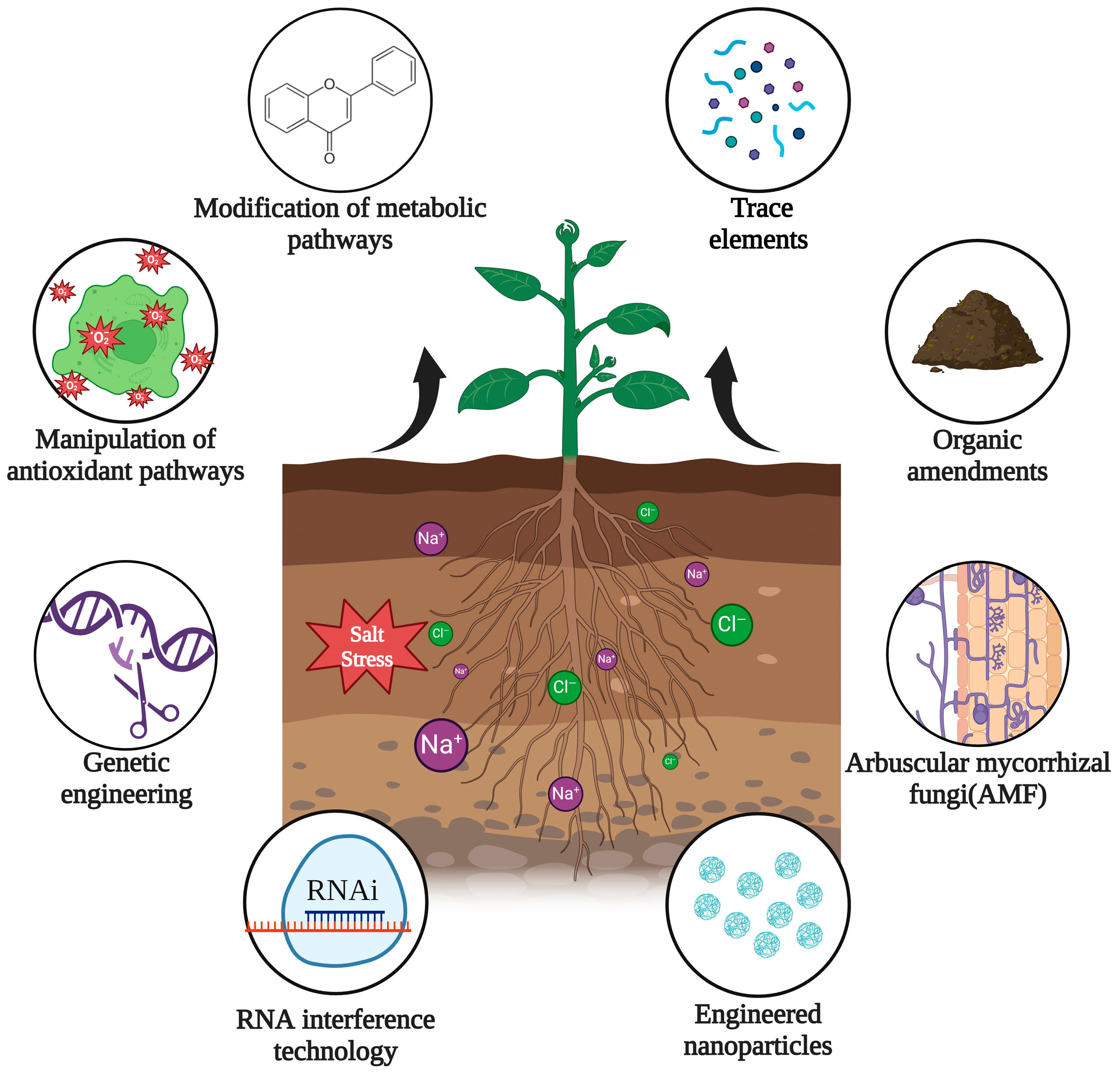

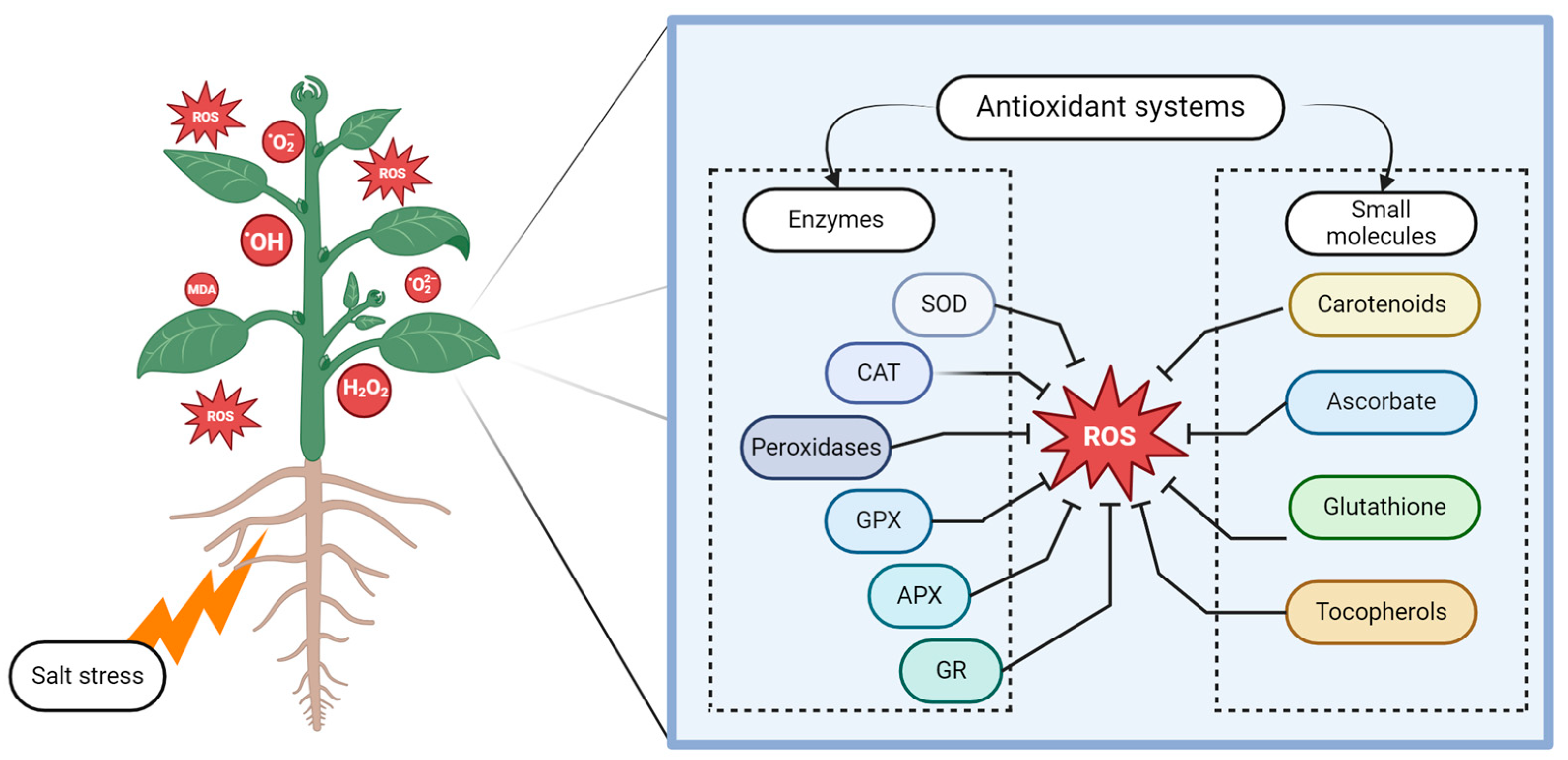
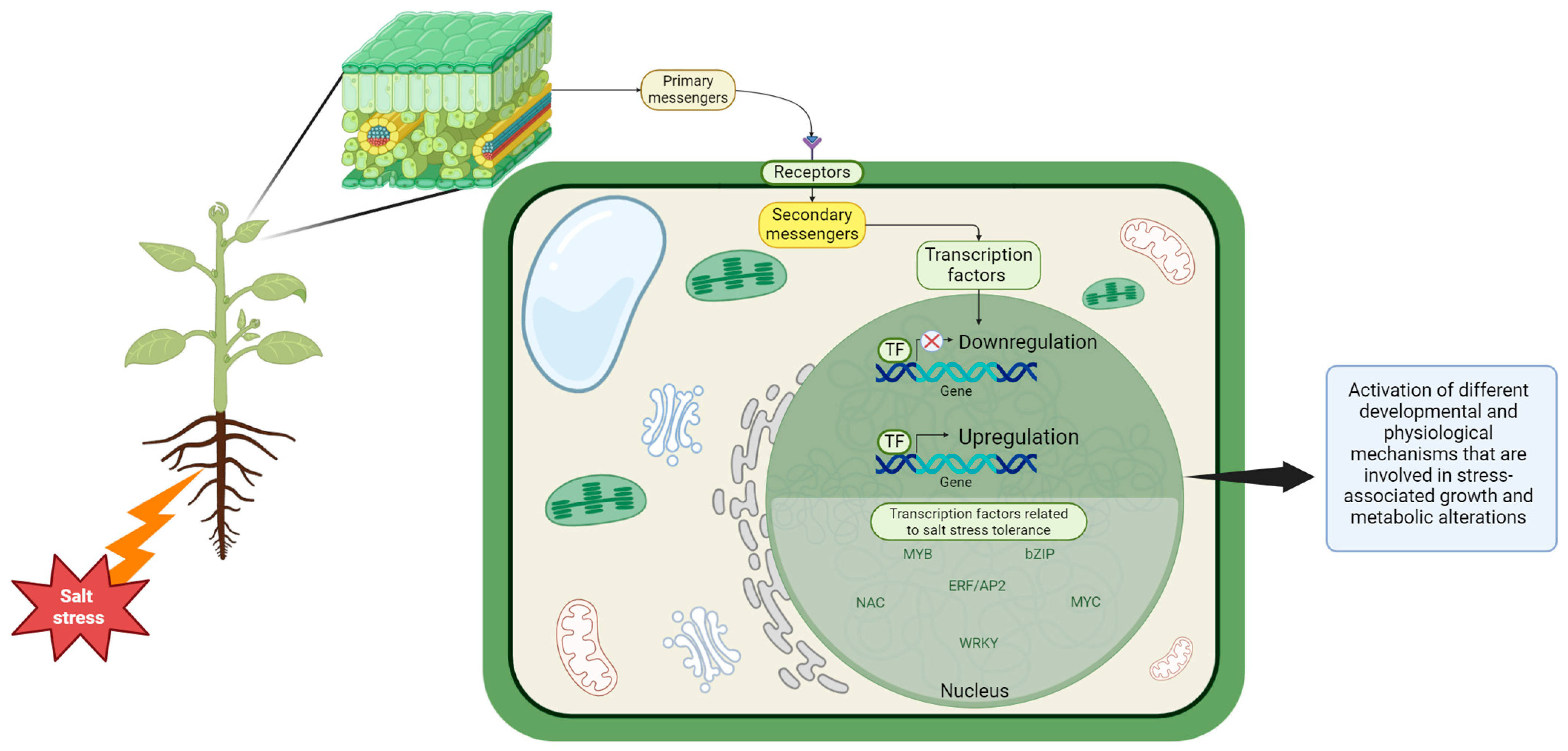
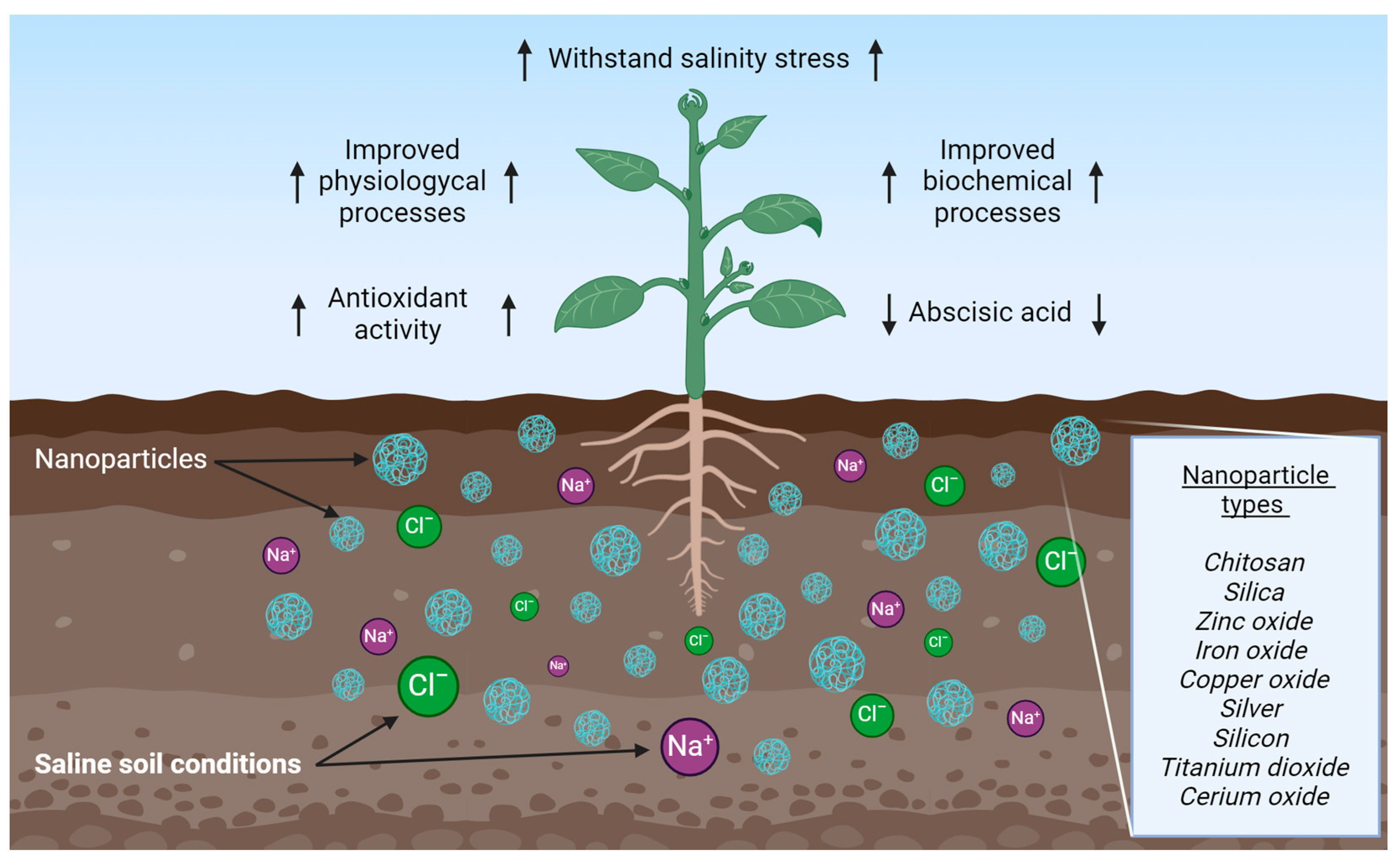
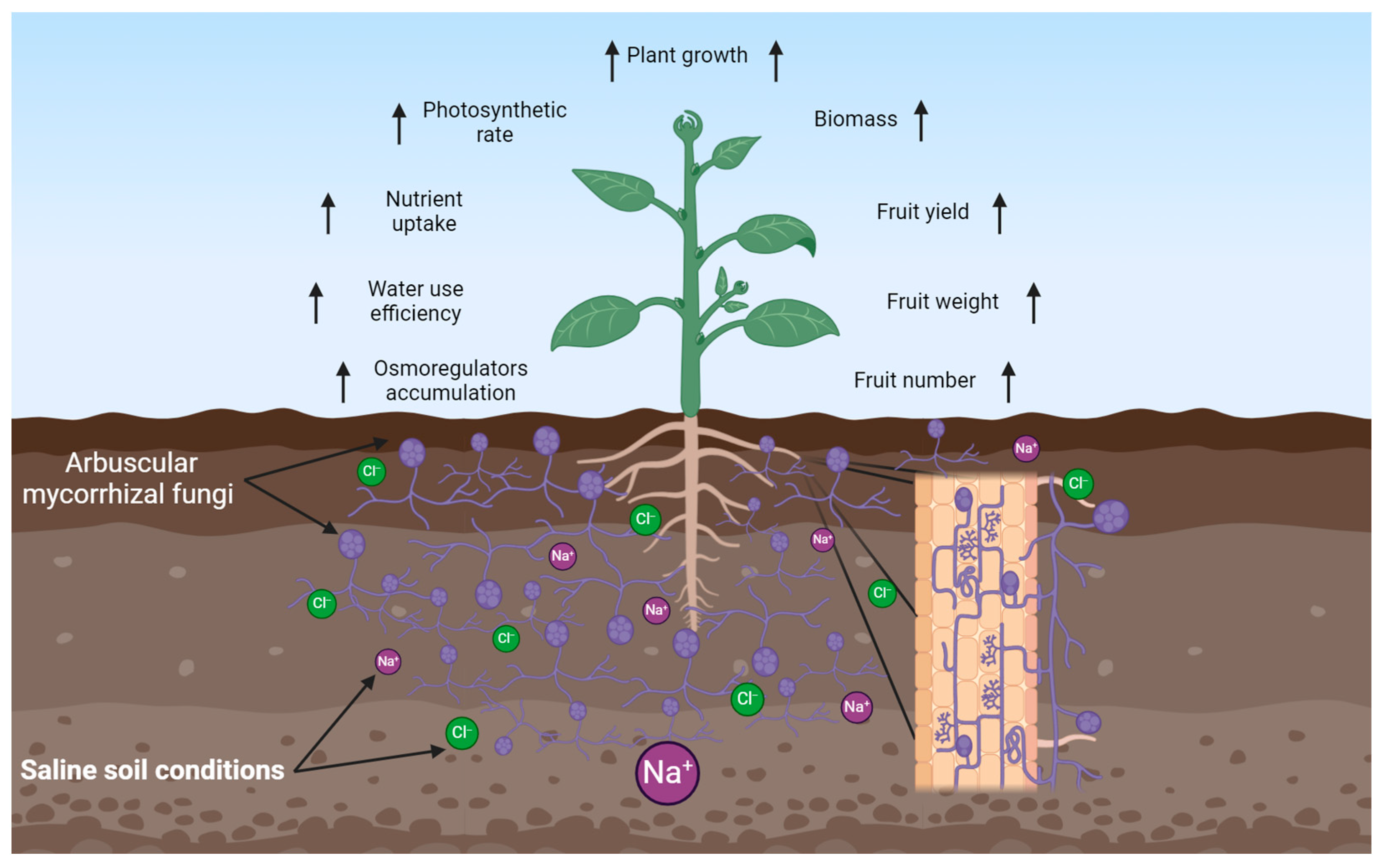
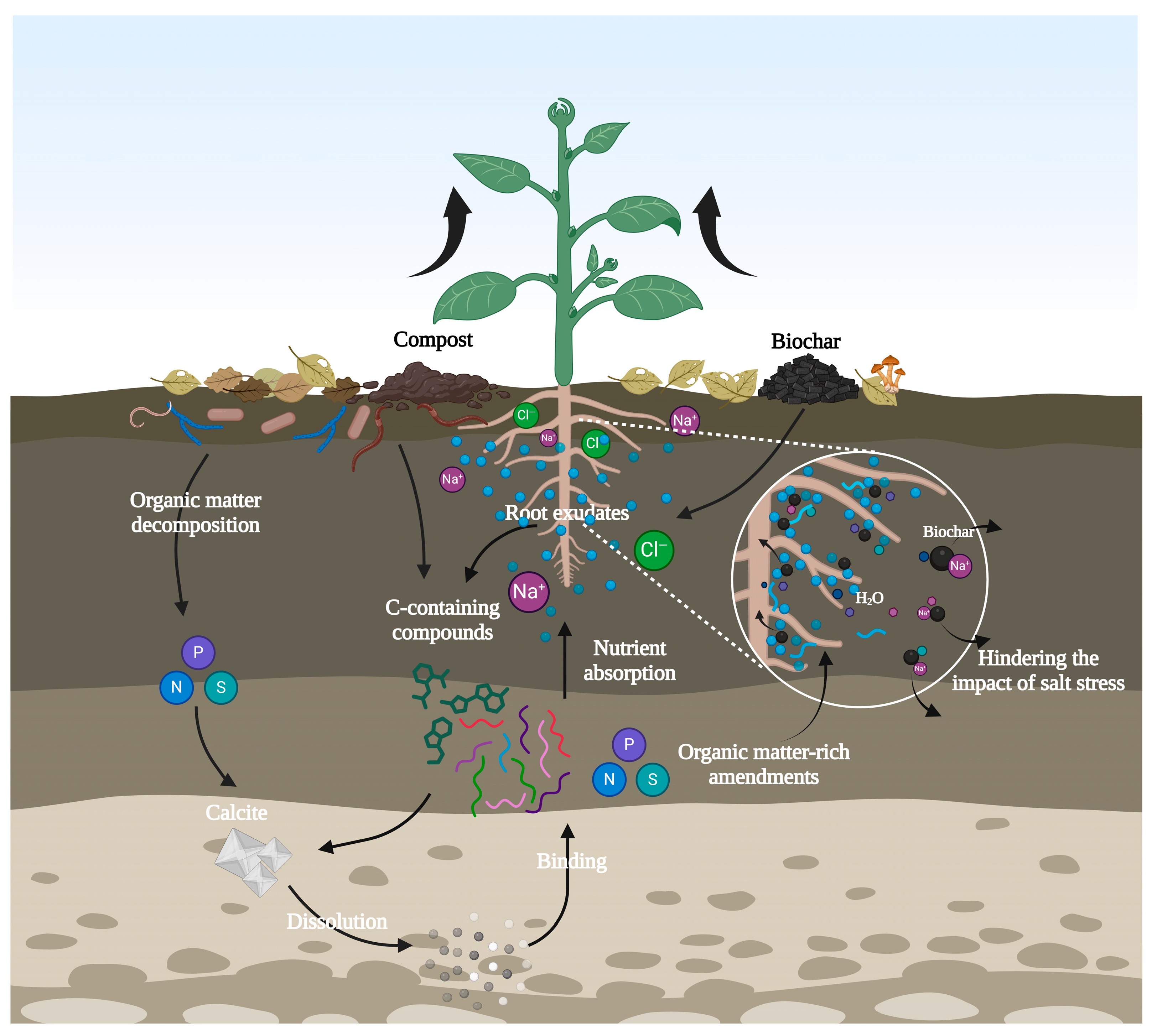
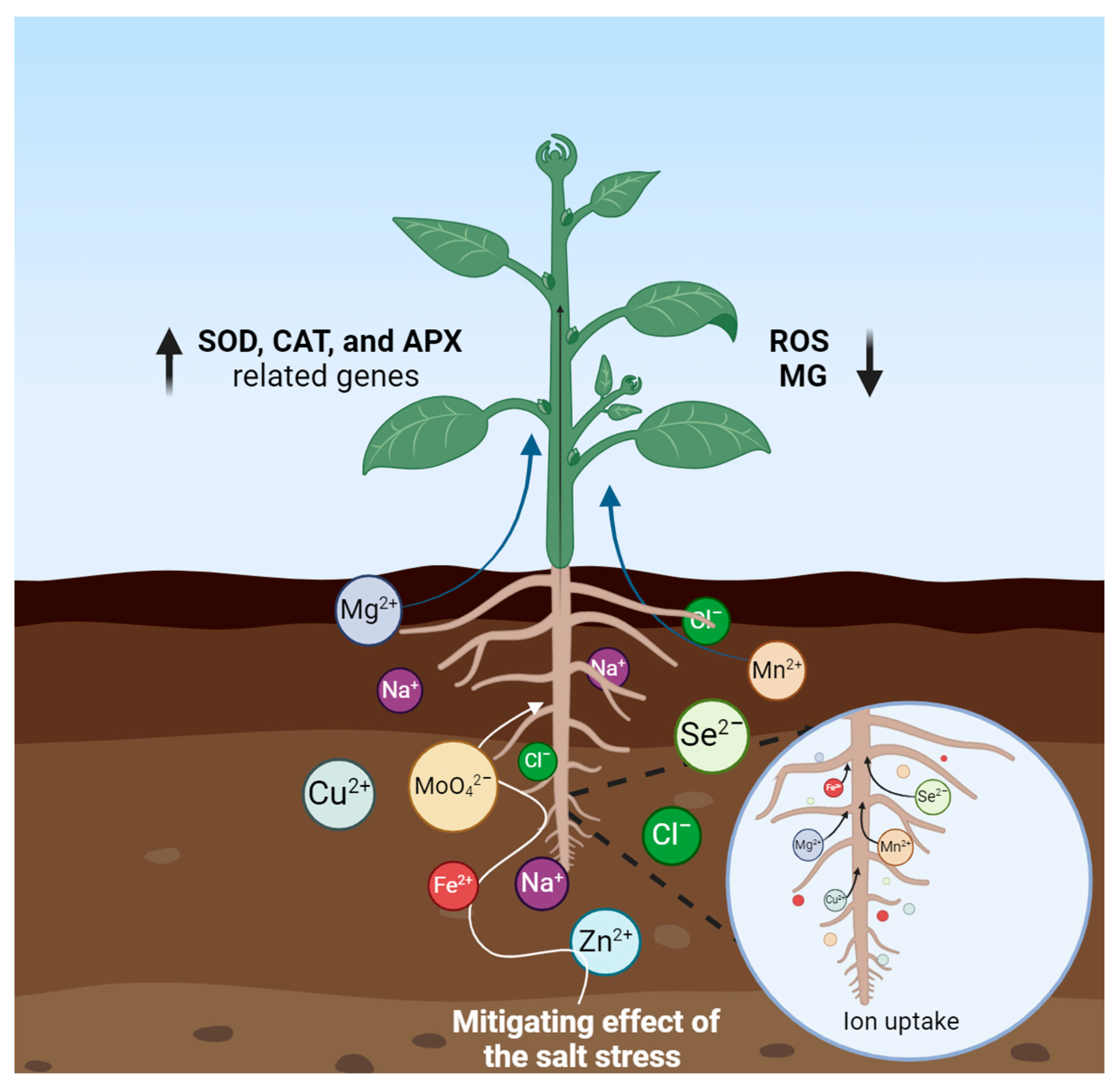
| Protein | Genes | Plants Host Genes | Gene Function | References |
|---|---|---|---|---|
| Na+/H+ antiporter in the plasma membrane | SOS1 | Ion balance; maintaining membrane vesicular trafficking | Oh et al., 2016 [23] | |
| GmSOS1 | Glycine max | Minimization of electrolyte leakage on leaf surface; decreasing Na+ concentrations in leaves | Zhao et al., 2017 [24] | |
| TdSOS1 | Triticum turgidum | Greater water retention capacity of shoots and roots; retained low Na+ and high K+ in shoots and roots | Feki et al., 2014 [25] | |
| CrcSOS1 CcSOS1 AjSOS1 | Crossostephium chinense Chrysanthemum crissum Artemisia japonica | Mediating Na+ efflux at the plasma membrane; | Gao et al., 2014 [26] | |
| Na+, K+/H+ exchangers | NHX | Osmoprotectant maintaining Na+/K+ ion transport in exchange for H+ in the cells under salt stress | Amin et al., 2021 [27] | |
| PutNHX1 SeNHX1 | Puccinellia tenuiflora Salicornia europaea | Improves Na+ sequestration in the vacuole and K+ retention in the cytosol and vacuole of root cells | Liu et al., 2017 [28] | |
| PeNHX | Populus euphratica | Sequesters Na+ into the root vacuoles to alleviate Na+ toxicity in stems and leaves | Ye et al., 2009 [29] | |
| SpNHX3 | Solanum pennellii | Increases transcript levels of vacuolar transporters of Na+ in leaves | Albaladejo et al., 2017 [30] | |
| SpNHX4 | ||||
| High-affinity potassium transporter | HKT | Decreases Na+ in the shoots; Na+ exclusion and K+ influx | Gu et al., 2023 [31] | |
| AvHKT1 | Actinidia valvata | Decreases accumulation of Na+ and K+; decreases lipid peroxidation (decreased MDA) | Gu et al., 2023 [31] | |
| BsHKT1;2 | Bienertia sinuspersici | Transports more Na+ into xylem parenchyma cells | Irulappan et al., 2023 [32] | |
| NsHKT1 | Nitraria sibirica | Prevents shoot Na+ accumulation; influences secondary metabolism and signal transactions | Zhang et al., 2024 [33] | |
| Na+/Ca2+ exchanger-like protein | NCL | Transports Ca2+ to the vacuole through the exchange of Ca2+ and Na+ | Yuan et al., 2024 [34] | |
| Ncl | Glycine max | Decreased accumulation of Na+, K+, and Cl ions in the shoots | Do et al., 2016 [35] | |
| AtNCL | Arabidopsis | Na+/Ca2+ exchange; maintenance of Ca2+ homeostasis | Wang et al., 2012 [36] | |
| Vacuolar Ca2+ regulation; auxin response; flowering time | Li et al., 2016 [37] | |||
| TaNCL2 | Triticum aestivum | Ca2+ enrichment in the cytoplasm by transporting it from the vacuole in the exchange of cytosolic sodium Na+ | Shumayla et al., 2023 [38] |
Disclaimer/Publisher’s Note: The statements, opinions and data contained in all publications are solely those of the individual author(s) and contributor(s) and not of MDPI and/or the editor(s). MDPI and/or the editor(s) disclaim responsibility for any injury to people or property resulting from any ideas, methods, instructions or products referred to in the content. |
© 2024 by the authors. Licensee MDPI, Basel, Switzerland. This article is an open access article distributed under the terms and conditions of the Creative Commons Attribution (CC BY) license (https://creativecommons.org/licenses/by/4.0/).
Share and Cite
Nurbekova, Z.; Satkanov, M.; Beisekova, M.; Akbassova, A.; Ualiyeva, R.; Cui, J.; Chen, Y.; Wang, Z.; Zhangazin, S. Strategies for Achieving High and Sustainable Plant Productivity in Saline Soil Conditions. Horticulturae 2024, 10, 878. https://doi.org/10.3390/horticulturae10080878
Nurbekova Z, Satkanov M, Beisekova M, Akbassova A, Ualiyeva R, Cui J, Chen Y, Wang Z, Zhangazin S. Strategies for Achieving High and Sustainable Plant Productivity in Saline Soil Conditions. Horticulturae. 2024; 10(8):878. https://doi.org/10.3390/horticulturae10080878
Chicago/Turabian StyleNurbekova, Zhadyrassyn, Mereke Satkanov, Moldir Beisekova, Alua Akbassova, Rimma Ualiyeva, Junfang Cui, Yangwu Chen, Zhaoqi Wang, and Sayan Zhangazin. 2024. "Strategies for Achieving High and Sustainable Plant Productivity in Saline Soil Conditions" Horticulturae 10, no. 8: 878. https://doi.org/10.3390/horticulturae10080878
APA StyleNurbekova, Z., Satkanov, M., Beisekova, M., Akbassova, A., Ualiyeva, R., Cui, J., Chen, Y., Wang, Z., & Zhangazin, S. (2024). Strategies for Achieving High and Sustainable Plant Productivity in Saline Soil Conditions. Horticulturae, 10(8), 878. https://doi.org/10.3390/horticulturae10080878







